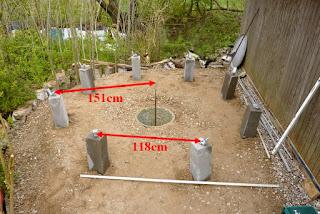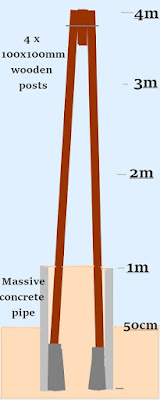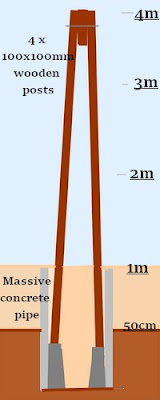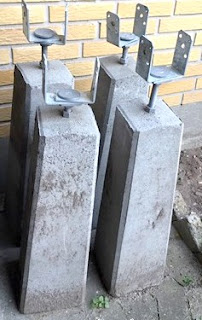*
With the concrete footings available I decided to set them out and measure up for the planned building dimensions.
The image shows the results. It is better to have the sides slightly short of 4' rather than too long. This allows whole 8'x4' plywood sheets to fit vertically without gaps.
The aerial image from a stepladder is horribly askew. The foreground alloy bar is actually at right angles to the shed to make the front face square with the house. This also ensures the gap between the shed and the nearest octagon face is even.
The gap between the buildings is not as much as I hoped but still provides reasonable access between them. There is a path for wheelbarrows on the other side of the shed.
Now the foundation blocks need to be buried. The nearness of the left blocks to the steep bank has already been mentioned. It requires much more sand & gravel to extend the bank outwards. Or taller posts [stilts] on that side to ensure proper anchorage to more deeply buried anchors. Not ideal, as easy access to the support bracket's height adjustment is lost. It also increases the risk of rot at the base of the timber posts. I may be completely sick of the sight of gravel but there is no option to getting more to do a proper job of the foundations.
The old satellite dish, on the far right, makes a handy cover to keep clumsy animals from falling into the concrete pier pipe. The water level remains abut two inches below the surface of the small stones I threw in.
Buried two of the concrete footings. Decided not to back fill them yet until I have run strings between them all to ensure alignment. It is very difficult to get the spacing correct using a tape measure and straight edges.
Later I added two trailers full of sand/gravel where the banks are steepest. Need even more! Those drops on the left are black holes! The gravel just disappears beyond the event horizon. It tests the compaction capabilities of the sand and gravel. Raking the gravel over the edge tends to lift just the stones which don't stick together like the more sandy stuff. If it wasn't restrained, by the heavy logs from the birch tree trunks, it would just roll away. It feels as if I need a long bat to compact the slopes but I don't have anything very useful unless I make something. So I am having to stamp on the slope as I rake more gravel over the top. The bank is about a meter high now as the original ground surfaces slopes gently away, from right to left, across the whole site. I'm trying to put a lot more material around the anchors on that side to avoid them breaking out through the top of the bank. The only answer is to keep adding more gravel.
The old satellite dish, on the far right, makes a handy cover to keep clumsy animals from falling into the concrete pier pipe. The water level remains abut two inches below the surface of the small stones I threw in.
Buried two of the concrete footings. Decided not to back fill them yet until I have run strings between them all to ensure alignment. It is very difficult to get the spacing correct using a tape measure and straight edges.
Later I added two trailers full of sand/gravel where the banks are steepest. Need even more! Those drops on the left are black holes! The gravel just disappears beyond the event horizon. It tests the compaction capabilities of the sand and gravel. Raking the gravel over the edge tends to lift just the stones which don't stick together like the more sandy stuff. If it wasn't restrained, by the heavy logs from the birch tree trunks, it would just roll away. It feels as if I need a long bat to compact the slopes but I don't have anything very useful unless I make something. So I am having to stamp on the slope as I rake more gravel over the top. The bank is about a meter high now as the original ground surfaces slopes gently away, from right to left, across the whole site. I'm trying to put a lot more material around the anchors on that side to avoid them breaking out through the top of the bank. The only answer is to keep adding more gravel.
Click on any image for an enlargement.
*







